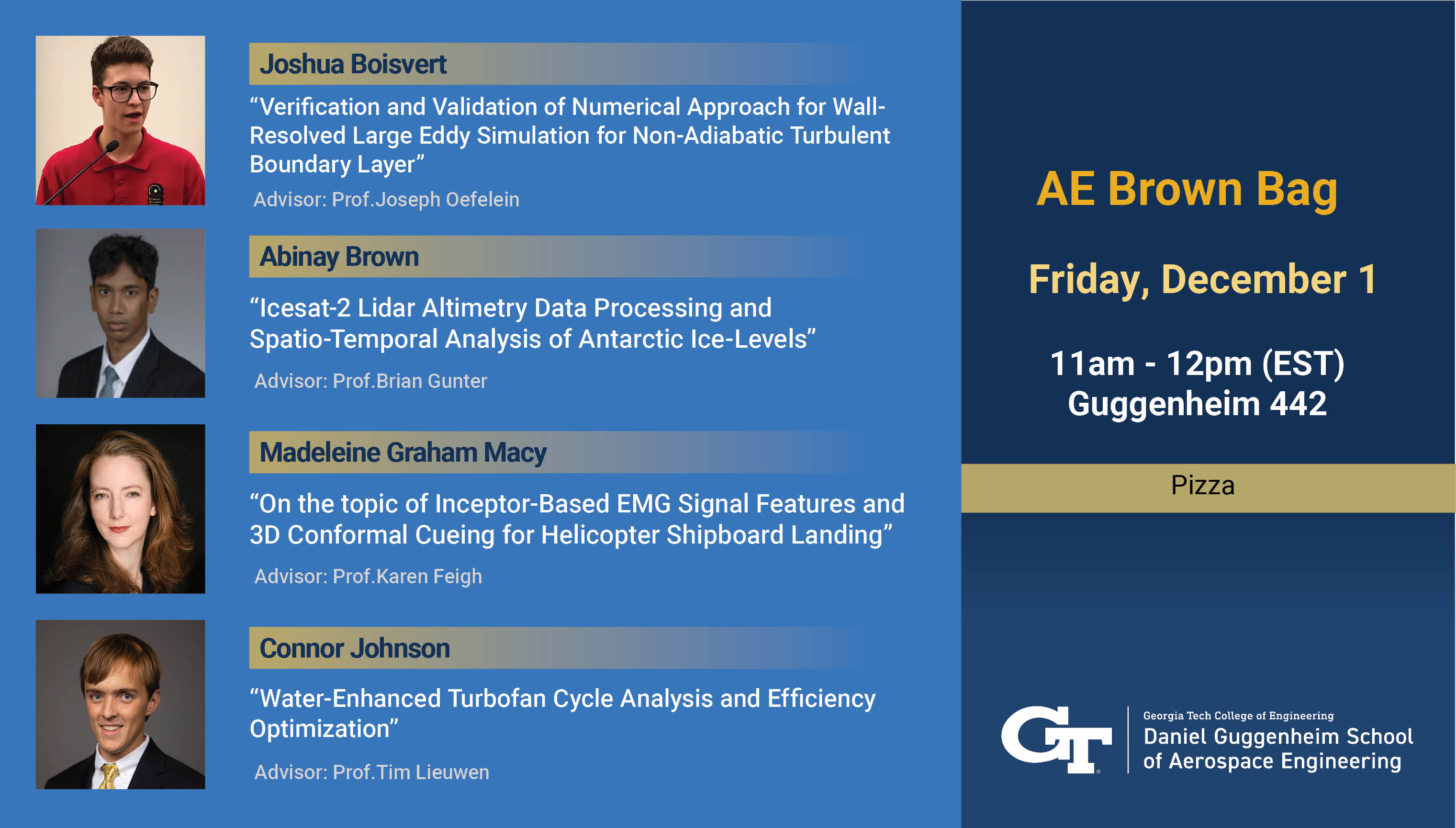
Brown Bag Seminar
Friday, December 1
11:00 a.m. -12:20 p.m.
Guggenheim 442
Pizza will be served
Presenters
Joshua Boisvert
Abinay Brown
Madeline Graham Macy
Connor Johnson
Joshua Boisvert
Title:
"Verification and Validation of Numerical Approach for Wall-Resolved Large Eddy Simulation for Non-Adiabatic Turbulent Boundary Layer"
Abstract:
The author presents the verification and validation of a Wall-Resolved Large Eddy Simulation (WRLES) of a nonadiabatic Mach 2.9 turbulent boundary layer. The boundary layer is a canonicalization of the upstream boundary layer of a shock-boundary layer interaction (SBLI). Several reference Direct Numerical Simulations (DNS) results are used to validate the numerical approach of the WRLES. Initial results of the WRLES approach do not align closely to the DNS data. After verifying boundary and freestream conditions matched those of the reference, it is found that the shock capturing limiter scheme is the primary factor in the disparity between the LES and DNS data. The limiter scheme is over-active near the wall, smoothing the large near wall velocity gradients, which feed into the scaling quantities used to normalize the Reynolds stresses. Turning off the shock-capturing limiters reduce the dissipative effects, and the results of the LES approach more closely align with the DNS reference data. The numerical approach can now be confidently used in further parameter studies of the canonicalized boundary layer for the SBLI.
Advisor:
Professor Joseph Oefelein
Abinay Brown
Title:
Icesat-2 Lidar Altimetry Data Processing and Spatio-Temporal Analysis of Antarctic Ice-Levels
Abstract:
The Icesat-2 is a NASA’s Earth Observing mission satellite used for measuring ice sheet elevation, sea ice thickness, as well as vegetation characteristics, and clouds. The Icesat-2 uses the ATLAS (Advanced Topographic Laser Altimetry System) to measure the travel time of laser photons from the satellite to Earth and back to determine the Ice sheet elevation. With nearly a trillion data points to process from the ATL06 land-ice dataset with increasing complexity, in this research, multiple techniques have been utilized to downsample the large elevation data into 0.5x0.5 degree grids for 36 months from 2019 to 2021.
For further analysis, the Empirical Orthogonal Functions (EOFs) for the gridded monthly elevation data have been derived to evaluate the top three dominant modes (eigenvalues) that measure top three percent spatial variances as well as the time (temporal) series of these three modes. Additionally, the EOFs of the cross-covariance of the 0.5x0.5 degree gridded land-ice elevation data and the Equivalent Water Thickness dataset, from the GRACE-FO satellite measuring the monthly changes in gravity, was also found for analyzing the spatio-temporal cross-correlation of the changes in land ice-levels and the monthly ice-mass levels.
Advisor:
Professor Brian Gunter
Madeline Graham Macy
Title:
On the topic of Inceptor-Based EMG Signal Features and 3D Conformal Cueing for Helicopter Shipboard Landing
Abstract:
The development of a metric to quantify rotary wing pilot workload is of interest to both the handling qualities and aviation human factors communities. The common workload tools are divided into three main elements: subjective assessments, physiological measurements and the analysis of the inceptor (i.e., cyclic,collective and pedals) dynamics. ... A combination of the three methods ideally will provide aeronautical researchers with sufficient breadth and depth of information such that they are able to draw some conclusions about the pilot’s performance of the prescribed mission task. Previous work at the Georgia Tech Rotorcraft Flight Simulation Laboratory addressed the inceptor element ("Quantifying Taskload and Workload with Instantaneous Power Spectrum: An Initial Assessment of 3D Conformal Cueing in Rotorcraft Shipboard Landings"). Specifically, it was demonstrated that the instantaneous power spectrum (IPS) could accurately track the pilot’s inceptor activity in the crossover frequency band. In the current work, we will address the physiological element of the workload triad. Common physiological measures include Electroencephalogram (EEG), Electrocardiogram (ECG), Electromyography (EMG), and pupillometry. In this study, we will particularly focus on the application of the EMG signals in relation to shipboard landing task.
Advisor:
Professor Karen Feigh
Connor Johnson
Title:
Water-Enhanced Turbofan Cycle Analysis and Efficiency Optimization
Abstract:
The Water-Enhanced Turbofan (WET) is a new engine architecture developed by MTU Aero Engines for the purpose of drastically reducing NOx emissions in future aircraft. The concept works by combining a traditional Joule-Brayton cycle engine with the Clausius-Rankine steam cycle, in which superheated steam is injected into the combustor at a prescribed water-to-air ratio (WAR). Due to the high specific heat capacity of water, the injected steam acts as a heat sink and lowers the temperature in combustor hot spots, reducing local NOx formation. Compared to traditional engine architectures, the WET concept is efficient in high-bypass ratio designs and has a smaller core engine volume. This presentation will cover the cycle analysis used to model the WET in steady state, a performance comparison to traditional turbofans, and optimization problems pursued in maximizing thrust-specific fuel consumption.
Advisor:
Professor Tim Lieuwen